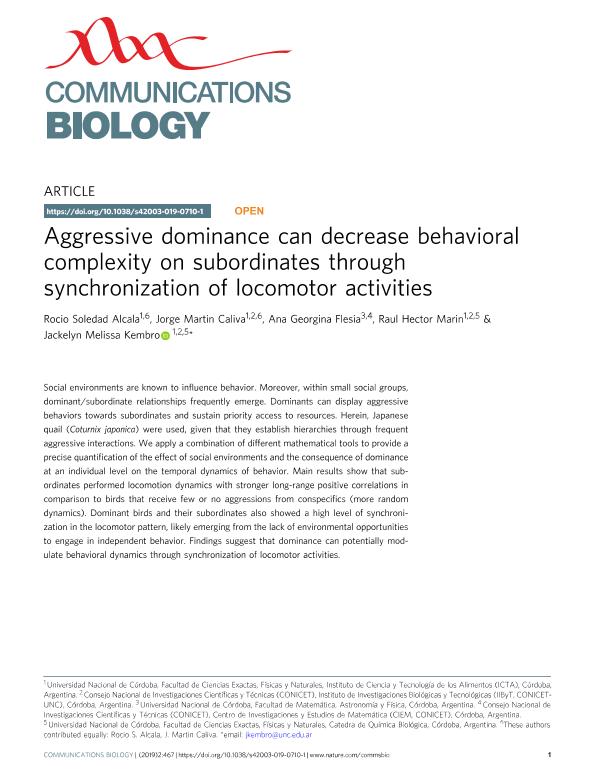Artículo
Aggressive dominance can decrease behavioral complexity on subordinates through synchronization of locomotor activities
Alcala, Rocio Soledad; Caliva, Jorge Martín ; Flesia, Ana Georgina
; Flesia, Ana Georgina ; Marin, Raul Hector
; Marin, Raul Hector ; Kembro, Jackelyn Melissa
; Kembro, Jackelyn Melissa
 ; Flesia, Ana Georgina
; Flesia, Ana Georgina ; Marin, Raul Hector
; Marin, Raul Hector ; Kembro, Jackelyn Melissa
; Kembro, Jackelyn Melissa
Fecha de publicación:
12/12/2019
Editorial:
Nature Publishing Group
Revista:
Communications Biology
ISSN:
2399-3642
Idioma:
Inglés
Tipo de recurso:
Artículo publicado
Clasificación temática:
Resumen
Social environments are known to influence behavior. Moreover, within small social groups, dominant/subordinate relationships frequently emerge. Dominants can display aggressive behaviors towards subordinates and sustain priority access to resources. Herein, Japanese quail (Coturnix japonica) were used, given that they establish hierarchies through frequent aggressive interactions. We apply a combination of different mathematical tools to provide a precise quantification of the effect of social environments and the consequence of dominance at an individual level on the temporal dynamics of behavior. Main results show that subordinates performed locomotion dynamics with stronger long-range positive correlations in comparison to birds that receive few or no aggressions from conspecifics (more random dynamics). Dominant birds and their subordinates also showed a high level of synchronization in the locomotor pattern, likely emerging from the lack of environmental opportunities to engage in independent behavior. Findings suggest that dominance can potentially modulate behavioral dynamics through synchronization of locomotor activities.
Palabras clave:
ANIMAL BEHAVIOUR
,
DATA PROCESSING
,
SCALE INVARIANCE
,
ETHOLOGY
,
QUAIL
Archivos asociados
Licencia
Identificadores
Colecciones
Articulos(IIBYT)
Articulos de INSTITUTO DE INVESTIGACIONES BIOLOGICAS Y TECNOLOGICAS
Articulos de INSTITUTO DE INVESTIGACIONES BIOLOGICAS Y TECNOLOGICAS
Citación
Alcala, Rocio Soledad; Caliva, Jorge Martín; Flesia, Ana Georgina; Marin, Raul Hector; Kembro, Jackelyn Melissa; Aggressive dominance can decrease behavioral complexity on subordinates through synchronization of locomotor activities; Nature Publishing Group; Communications Biology; 2; 467; 12-12-2019; 1-14
Compartir
Altmétricas



